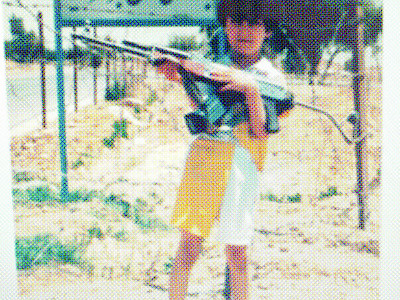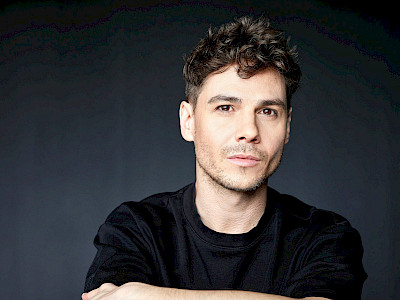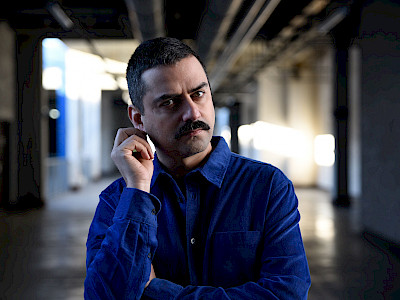13 — 18.05.2024
Gurshad Shaheman, Dany Boudreault Limoges-Montreal
Sur tes traces
theatre — premiere
| French → NL, EN | ⧖ ±2h | €20 / €16 | Contains references to suicide and sexual violence
Dany Boudreault was born on the shores of Lake Saint-Jean in Quebec, a rural environment; Gurshad Shaheman is a native of the Islamic Republic of Iran, where he spent the first twelve years of his life. Starting with a list of the people – family, first loves, friends, even enemies – and the places marking the fights and frolics of their youth, Boudreault and Shaheman each took on the task of working back up-stream through the river of the other's life, creating a new portrait of it. Following the two writer-performers who themselves often had to make tough choices among the multiple narratives, the audience experiences the narration through multi-channel headphones, allowing them to select the accounts they wish to follow. Together, Boudreault and Shaheman offer the keys to their personal archives, through a writing style that combines a travel journal and a character investigation. In speaking of the other, one inevitably speaks about oneself, but also and above all about others. Spanning the oceans, the personal and political accounts interlink, finding an echo in each one of us.
Sur tes traces
You literally set out to follow in each other’s footsteps. What path did each of you take?
Gurshad Shaheman – We started the project with a joint trip to Sarajevo in October 2022. It was a city we didn’t know and whose languages we didn’t speak. We were naturally affected by the scars of the war, which were still very present, and by the distinct separation between the Turkish and Austro-Hungarian parts of the city, which goes some way to illustrating the necessity of our approach to each other... We told one another about our lives, and drew up a list of people and places to visit. Then in June 2023, we arranged to travel [to the respective places] at the same time. I went to Montreal and to the shores of Lac Saint-Jean, where Dany was born. I met his colleagues, friends and family. His sister took me on a tour of the old family farm. I was there just as northern Canada was going up in flames, and my road trip had the smell of a forest fire. So my path lies somewhere between a portrait of Dany and a travel diary.
Dany Boudreault – I went to Lille, Paris, Toulon and Turkey. I’ve been trying to get to Iran for a long time, but diplomatic relations with Canada are very bad, so we decided that I would go to the Turkish-Iranian border and see how this impasse could also leverage my writing. I was exposed to a veritable Tower of Babel. To speak with Gurshad’s uncle and aunts, I had a Farsi interpreter, but I was able to speak German with one of them and English with a former lover... This pilgrimage towards the ‘other’ is also a way of discovering new territories, both physical and symbolic.
So you’ve collected lots of material, many elements to use in your performance. What was your writing process like?
DB – Such an enormous amount of material! Which implies making choices, sometimes difficult ones. But at some point, those encounters become dramaturgical elements – less a question of the place that the person occupies in our lives and the intimacy that connects us to them than of the overall balance of the text. The audience will also have to choose... In any case, we’re always wrong about what we haven’t chosen!
GS – After our respective journeys, we met up in Montreal and spent three weeks clearing the ground and drawing up a plan. Then we each wrote our script on our own. The piece consists of two monologues in which each of us addresses the other: I tell him about my trip and Dany tells me about his, simultaneously. The viewers are given headphones and choose who they want to listen to. They can switch from one person to the other, but when they tune-in to me, I am talking about Dany, and vice versa. Some stories stand out. For example, Dany’s aunt tells me: “There are two artists in the family, Dany and his cousin who’s a thanatologist,” and then describes all the things he’s capable of doing with a body, so it’s obvious that we would include this story in the piece. And the way she tells it, the comparison between thanatology and theatre, both ephemeral arts, is fantastic.
Why did you choose to separate the two stories by having people listen to them through headphones?
GS – Three years ago, when we came up with the idea for this piece, the world was a more peaceful place: there was no war in Ukraine; Mahsa Amini had not been murdered in Iran; and the situation was not the same in Gaza. In an increasingly polarised world, the perception of our identities changes in spite of ourselves. Dany and I had to get round the labels of our origins: Quebec and Iran, East and West looking at each other. I’m more likely to be presented as Iranian than French, because it’s the farthest pole, the most exotic, and society likes to play on this opposition. So we chose to challenge that binarity in a radical and playful way, by offering the viewers a choice between East and West. But when you choose the one, it tells you about the other. The idea is to try to understand how the other person has been shaped, what has shaped them... With headphones, there is a very strong sense of intimacy.
DB – It’s also a piece about borders, about the privilege of being mobile –you can be mobile on one route, but not on another, why? My inability to go to Iran also speaks of Gurshad’s inability to return.
GS – Since I cannot go back to Iran, I send a friend, but even that attempt fails. Dany went to Turkey because Azeri, my mother tongue, belongs to the Turkic language group; my father couldn’t leave Iran to join him, and Dany decided to go as far as the Iranian border without being able to cross it. This really touched me... When I was 11, my mother queued every morning outside the French Embassy to get her visa, and this went on for months – she queued in the hope of getting in; even the French Embassy was inaccessible to us... The fact that Dany finds himself in a similar situation is very powerful.
Can you describe the stage set?
GS – The arrangement is frontal. Sur tes traces takes place behind a tulle curtain in a kind of flat that could be the one in Sarajevo. All the walls are veiled, and the more you discover about each other’s geography, the more you move into the flat, the more it reveals itself. Nothing is direct, everything is reminiscent, replayed for the other. There’s also a lot about shadows –the shadows of the people who made us and who live on through us... We are the transmitters of the story we have each written, but also a projection medium for the figures in the other’s story.
What meaning do you think is conveyed by Sur tes traces?
DB – It’s a story about twins, about symmetry, about seeing how our sufferings sing together and how we can find consolation in that. It’s a declaration of love. When you love someone, you’re always looking for affinities, but that’s an illusion. We have to embrace our differences and stop obsessing about the similarities.
- Interview conducted by Maïa Bouteillet, April 2024.
Presentation: Kunstenfestivaldesarts, Théâtre Les Tanneurs
Text, direction and performance: Gurshad Shaheman & Dany Boudreault | Assistant director: Renaud Soublière | Sound design: Lucien Gaudion | Set design: Mathieu Lorry-Dupuy | Lighting design: Julie Basse assisted by Joëlle Leblanc | Dramaturgy: Youness Anzane, Maxime Carbonneau | Stage management: Pierre-Éric Vives | Costumes: Bastien Poncelet | Trainee set design: Léa Salesse | Administration: Emma Garzaro | Production manager: Julie Kretzschmar | Quebec production: Jérémie Boucher | Dany Boudreault's guide/interpreter in Turkey: Saeed Mirzaei | Transcription: Khadija Fadhel | A project by La Ligne d’Ombre & La Messe Basse
Production: Les Rencontres à l’échelle – B/P | Coproduction: Kunstenfestivaldesarts, Théâtre Les Tanneurs, Festival TransAmériques, Maison de la Culture – Scène nationale d'Amiens, Le Manège – Scène nationale de Maubeuge, Quai – CDN Angers Pays de la Loire, CCAM - Scène nationale de Vandoeuvre-lès-Nancy, Théâtre de la Bastille, Festival d’Automne à Paris, Théâtre Prospero
With the support of DRAC Hauts-de-France, CALQ, CAC, Fondation Cole, CAM
Special thanks to Le Phénix – Scène nationale de Valenciennes and Théâtre de L’Union – CDN de Limoges
Performances in Brussels with the support of the Québec Government Office in Brussels & the French Embassy in Belgium and the Institut français Paris as part of EXTRA, a program that supports French contemporary creation in Belgium





